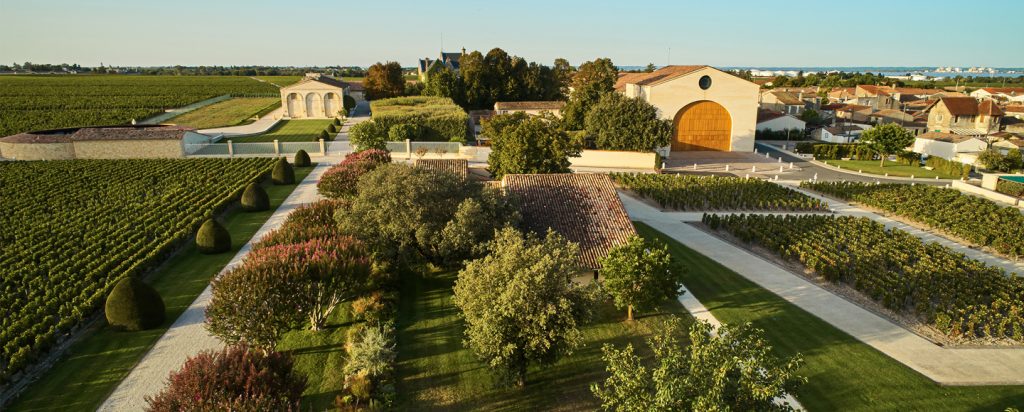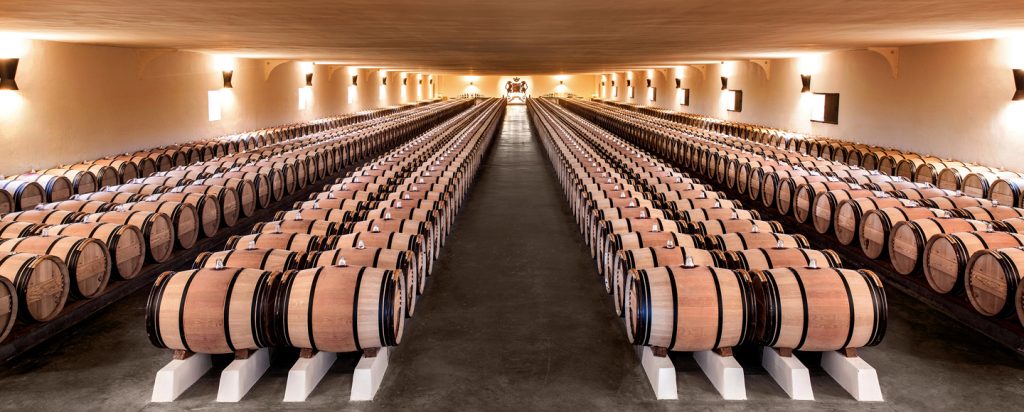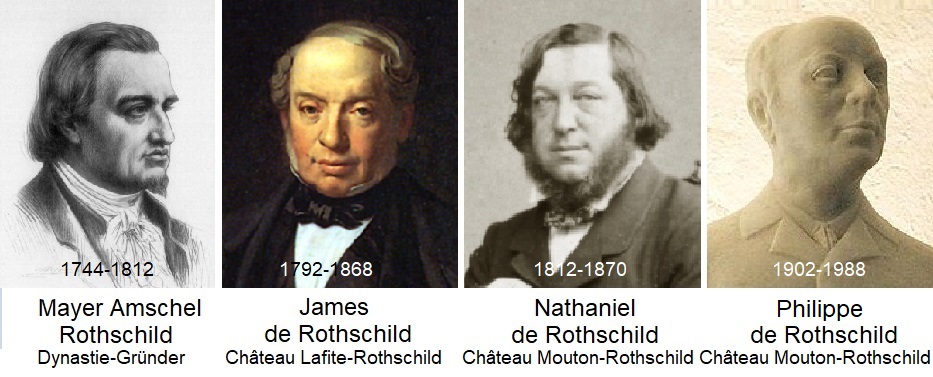The birth of Amschel Meyer in 1744 marks the beginning of the illustrious Rothschild family. Amschel Meyer started building his wealth while employed as a merchant at “zum Roten Schild,” which subsequently evolved into the Rothschild family name.
His sons were sent to different cities in 1798 to make their own fortunes. It goes without saying that his sons all enjoyed success, as did their offspring. Their desire to own a chateau in Bordeaux eventually resulted from this. Chateau Brane Mouton caught Nathaniel de Rothschild’s attention.
Chateau Mouton Rothschild
33250 Pauillac
Joseph de Brane, who purchased the estate from Nicolas-Alexandre de Segur in 1720, is credited with giving Chateau Brane Mouton its name. A number of renowned Bordeaux estates, such as the still-named Chateau Calon Segur, Chateau Latour, and the later-named Chateau Lafite Rothschild, were owned and built by the de Segur family!
The name Chateau Brane-Mouton was created when the new owner, Joseph de Brane (who also owned Brane Cantenac in Margaux), combined his last name with Mouton, which means “small hill.”
After Nathaniel de Rothschild bought Brane Mouton from Isaac Thuret in 1853, the official birth of what is now known as Chateau Mouton Rothschild occurred. A new chateau was needed, and the vineyards needed to be extensively replanted due to the estate’s lack of maintenance. Less than what he had paid for the land 23 years prior was sold by Isaac Thuret.
Chateau Mouton Rothschild was created when Baron Nathaniel de Rothschild, an English member of the Rothschild family, renamed the property using his name along with a portion of the original name, adhering to the custom of the day.
James Rothschild, a different Rothschild relative, bought Chateau Lafite in 1868. The five pointed crests that can be found on the labels of the wines made by the Rothschild family are meant to honour their five sons from the first generation.
Throughout his life, James Rothschild never went to Chateau Mouton Rothschild. The estate served only as a financial tool. It was not until the following generation that a family member lived and visited Chateau Mouton Rothschild.

Mouton Rothschild Chateau Modern Times
One could argue that the Bordeaux wine region underwent a modernization concurrent with the beginning of Chateau Mouton Rothschild’s modern era. It was relatively recent in terms of time. particularly in light of the appellation’s past. It was, in actuality, less than a century ago.
Both incidents began when Chateau Mouton Rothschild was taken over by the youthful, at the age of 20, Baron Philippe Rothschild. The Baron revolutionised Bordeaux wine production and distribution.
Many of the methods and techniques that the Baron introduced at Chateau Mouton Rothschild were viewed as radical in the 1920s, especially after he made changes to the estate starting in 1922. Still, all of the leading Bordeaux wine producers follow them to this day.

By now, the Left Bank property was already well-known throughout the world for its wines. However, some knew the estate could make better wine, chief among them the young Baron Philippe Rothschild. He was certain that Chateau Mouton matched any Medoc First Growth wine in quality.
First classified in 1855, Chateau Mouton Rothschild was classified as a Second Growth. He set out to obtain Mouton Rothschild’s much-desired First Growth status.
Although it will always be a feather in Mouton Rothschild’s cap, the fact that Chateau Mouton Rothschild is the only First Growth still owned by the same families since the famous 1855 classification might be even more significant.

Bordeaux Under Baron Philippe Rothschild’s Change
It is truly remarkable what the Baron managed to achieve at Mouton Rothschild in just two years. The Baron was the first owner of Bordeaux to mandate that all of his wine be bottled on the property.This was regarded as an odd concept at the time. This gave him complete control over the wine that he offered for sale from Mouton Rothschild.
Before then, negociants would purchase wine from chateaux and bottle it themselves, selling it to consumers. Typically, negociants would purchase the wine in barrels.
Remember that bottling on the premises was a novel idea at the time. Baron Philippe Rothschild commissioned the Cubist artist Jean Carlu to design a special label for the 1924 Chateau Mouton Rothschild label in an effort to elevate the chateau’s bottling start in the eyes of the public.
This was the forerunner to the now-famous artist-designed bottle labels that were introduced in 1945. The need for additional storage on the property arose from their recent practise of bottling their own wine. The Baron built the well-known “Grand Chai” of Mouton Rothschild.
The Baron acquired Chateau Mouton d’Armailhacq, a Fifth Growth vineyard, which was located nearby, in 1933. His wife, the Baroness Philippine, renamed the property Chateau d’Armailhac in 1989. A negociant firm that eventually became known as “Baron Philippe de Rothschild S.A.” was part of the reason for the purchase.
Baron Rothschild expanded his holdings in Pauillac in 1970 when he bought Chateau Clerc Milon, which is situated close to Mouton Rothschild’s vineyards.
Concurrently with increasing his Pauillac holdings, Baron Philippe Rothschild made another significant breakthrough for the Bordeaux industry. He was the first to produce a globally recognised brand of wine that could be purchased by any customer at a reasonable price.
The origins of what would become Mouton Cadet can be found in the 1930s, after three very bad vintages. In order to improve the quality of the Grand Vin, Chateau Mouton Rothschild’s second wine was actually known by the name Mouton Cadet when it was first produced.
The three challenging vintages prevented Chateau Mouton Rothschild from producing a significant amount of wine at the level that was anticipated, so the Baron decided to call the winery Mouton Cadet, which roughly translates to “Youngest brother of Mouton.” After then, the wine was marketed as Mouton Cadet.
This custom took hold, and by the middle of the 1950s, the wine was the most widely consumed branded, low-cost Bordeaux wine worldwide.
Labels with artist designs by Mouton Rothschild
In 1945, the now-famous series of labels that were featured on the Mouton Rothschild labels began. Both the wine and the times were ideal for the debut label. The Baron selected an image that represented the Liberation of France.
The iconic “V” for Victory label marked the beginning of a tradition! From then on, every label vintage was based on an original artwork made by well-known artists especially for this purpose. Many well-known artists have contributed to this tradition, including Salvador Dali, Miro, Chagall, Braque, Picasso, Warhol, Bacon, Balthus, Tàpies, and David Hockney.
Chateau Mouton Rothschild Statue First Growth Status for Mouton Rothschild
The Baron always saw Mouton Rothschild as a first-growth vineyard. But when it was classified in 1855, it was regarded as a second growth. Nobody thought the classification would ever be changed, even after it had been in place for more than a century without a single modification.
Other than Baron Philippe, that is. With the 1973 vintage, Château Mouton Rothschild was formally designated as a “Premier Cru Classé” (First Classified Growth), making him the only person to successfully overturn the 1855 classification.
The 1973 Chateau Mouton Rothschild front label was proud to announce this historic event.
Premier je suis, second je fus, Mouton ne change
First I am, second I was, I Mouton do not change.
Barone Influences of Philippine de Rothschild The Rothschild Mouton
The baron’s daughter, Baroness Philippine de Rothschild, who had long been involved in her father’s endeavours, succeeded her father when he passed away in 1988.
In 1991, the Baroness started making Aile d’Argent, a white wine that created quite a stir at the time.
Her next significant choice was to hire Philippe Dhalluin, a former director of St. Julien’s Chateau Branaire Ducru. Up until 2020, Philippe Dhalluin resided at Mouton Rothschild.
Philippine de Rothschild expanded their holdings in 2006 when they bought Chateau Colombier Monpelou, a 24-hectare vineyard. It is anticipated that the majority of those vines will be utilised going forward to create Chateau d’Armailhac.
The Baroness oversaw a multi-year, comprehensive renovation of Chateau Mouton Rothschild’s winery. The building project was finished in 2013. Richard Peduzzi, a theatrical designer, and renowned architect Bernard Mazieres collaborated to design the new cellars.
The extensive renovations included the installation of a brand-new, cutting-edge gravity-fed vinification cellar. The windows that were added to the large fermentation vats made of oak were one of the inventive ideas. The winemaker can see inside the vat from top to bottom thanks to these large glass windows.
The winemaker can now see inside each vat during fermentation and observe the interaction between the skins and juice, as well as what is happening during extraction, all from this vantage point. Whether and more a pump-over is required. It puts you in the closest possible position within the vinification process.
Both the art galleries and the renowned Mouton Rothschild wine museum underwent a complete renovation. Completed in time for the 2013 harvest at Mouton Rothschild, the new cellars are estimated to have cost over 25 million euros.
On August 22, 2014, Baroness Philippine Rothschild passed away at the age of 80. Her three children, Julien de Beaumarchais de Rothschild, born in 1971, Philippe Sereys de Rothschild, born in 1963, and Camille Sereys de Rothschild, born in 1961, survive her. The eldest child of Baroness Philippine Rothschild and her first husband, Jacques Sereys, Philippe Sereys de Rothschild was named Chateau Mouton Rothschild’s new president in October 2014.
The wines
One thought on “Beyond Bordeaux: Chateau Mouton Rothschild’s Global Wine Influence”